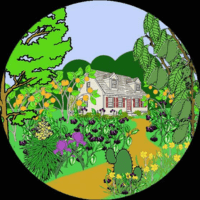Allium genus - all plants Chives, Garlic, Leek, Onion, Ramp, Wild & more!
Allium is the genus of herds and culinary delights! The Allium family includes Chives, Garlic Chives, all types of Onion (bulb, green, scallions, shallot & wild), Garlic (bulb & wild), Leek, and Ramp.
Sometimes the differences are subtle and sometimes not. No one mistakes bulb garlic with a green onion ;). But green onion vs scallion or garlic chives vs chives could be tricky.
So many species of Allium are eaten around the world.
________________________________________
see our list of 400 edible plants
YouTube channel (plz subscribe)
YouTube playlist for Herbs
this webpage is being written now,
March – May 2023
Allium Plant Guide on ONE webpage!
On this page:
- Allium species
- Allium Health Benefits
- What’s the Difference?
- Garlic Chives vs Chives
- Green Onion vs Scallion
- Garlic vs Elephant Garlic
- Cultivated vs Uncultivated Allium species
- Cultivated species
- Uncultivated species
Allium species
Allium is a genus (parent) with hundreds of species (children). in Latin, Allium means Garlic.
xxxxxxxxxxxxxxxxxxxxxxxxxxxxxxxxxx
Common varieties
Allium is a genus (parent) with hundreds of species (children). in Latin, Allium means Garlic.
xxxxxxxxxxxxxxxxxxxxxxxxxxxxxxxxxx
Chivey
- Chives
- Garlic Chives
Garlicy
- Garlic
- Elephant Garlic
Leeky
- Leek
Oniony
- Onion
- Chinese Onion
- Green Onion (Scallion or Bunching Onion)
- Shallot
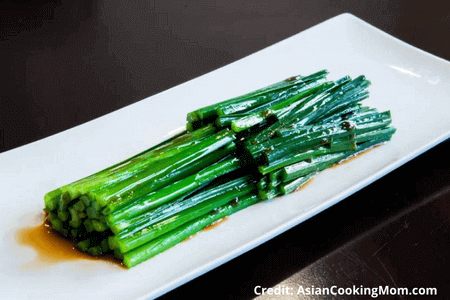
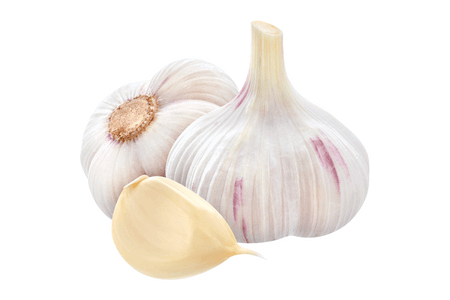
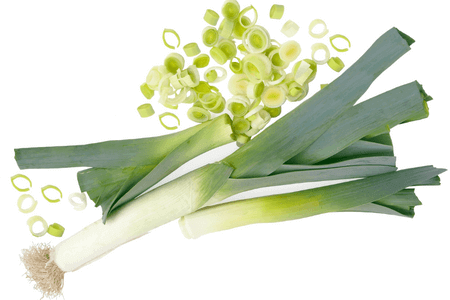
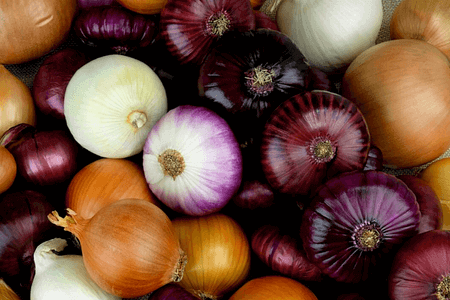
UNcommon varieties
Allium is a genus (parent) with hundreds of species (children). in Latin, Allium means Garlic.
xxxxxxxxxxxxxxxxxxxxxxxxxxxxxxxxxx
Chivey
- Chives
- Garlic Chives
Garlicy
- Garlic
- Elephant Garlic
Leeky
- Leek
Oniony
- Onion
- Chinese Onion
- Green Onion (Scallion or Bunching Onion)
- Shallot
Allium Health Benefits
Allium species have been studied for possible cancer treatment (garlic, onions, leeks, chives, and shallots). another study cites, “Allium species constituents have been shown to have antibacterial and antioxidant activities…[and] other biological properties. These activities are related to their rich organosulfur compounds. These organosulfur compounds are believed to prevent the development of cancer, cardiovascular, neurological, diabetes, liver diseases as well as allergy and arthritis.” they don’t just taste great, they’re good for you!
research from NIH/PubMed.
overall, Allium species are their benefits to human health:
- Allium species are investigated for “possible future” cancer treatment (NIH/PubMed, Allium vegetables for possible future of cancer treatment). that’s from a study with a wonderfully nebulous title :/.
- “The Allium species constituents have been shown to have antibacterial and antioxidant activities … These activities are related to their rich organosulfur compounds…organosulfur compounds are believed to prevent the development of cancer, cardiovascular, neurological, diabetes, liver diseases as well as allergy and arthritis.” (NIH/PubMed, Chemical constituents and medicinal properties of Allium species).
- Allium species contain secondary metabolites such as polyphenols, flavonoids and tannins and have bioactivity such as antioxidants, antibacterial, antifungal, anti-inflammatory, pancreatic α-amylase, glucoamylase enzyme inhibitors and antiplatelets. (NIH/PubMed, Antioxidant Properties and Structure-Antioxidant Activity Relationship of Allium Species Leaves).
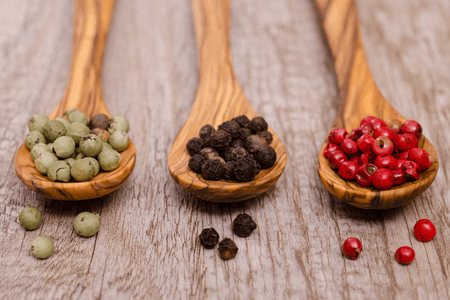
What's the Difference between Garlic Chives vs Chives
Allium is a genus (parent) with hundreds of species (children). in Latin, Allium means Garlic.
xxxxxxxxxxxxxxxxxxxxxxxxxxxxxxxxxx
Difference between Garlic Chives vs Chives
Similarities
- perennial plants that grow from small bulbs (bulbs much smaller than a green onion).
- grows in dense clumps.
- tubular, grass-like, dark green “leaves” about 12″ tall.
- virtually pest and disease free.
- used a flavor and color in culinary dishes.
- insecticidal (repellent) qualities.
Differences
- flowers. Garlic Chives have white flowers and Chives have purple flowers.
- hardiness. Garlic Chives is hardier. they can withstand lower amounts of water than Chives.
- taste & smell. Garlic Chives have a much stronger flavor profile, with strong Garlic taste and smell. Garlic Chives’ crushed ‘leaves’ give a distinct chivey garlicy smell.
- ‘leaves’. both have tubular, grass-like, dark green “leaves” about 12″ tall. however, Garlic Chives’ leaves are about twice the diameter and a bit flatter. Chives have thinner leaves and they’re round.
- aggressiveness. Garlic Chives aggressively self-seed. we top (deadhead) blooms immediately. Garlic Chives have a more well-rooted bulb. they don’t pull out of soft soil without the use of a hand shovel. it’s dense clump expands quicker; however, that is easily manageable. deadhead the Garlic Chive. if not, you’ll have the plant spread wider and wider each year.
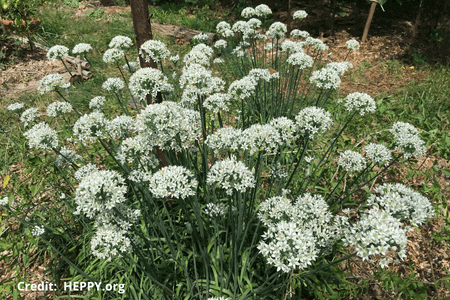
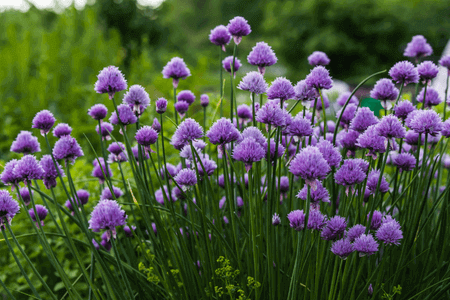
Difference between Green Onion vs Scallion
Similarities
- perennial plants that grow from small bulbs (bulbs much smaller than a green onion).
- grows in dense clumps.
- tubular, grass-like, dark green “leaves” about 12″ tall.
- virtually pest and disease free.
- used a flavor and color in culinary dishes.
- insecticidal (repellent) qualities.
Differences
- flowers. Garlic Chives have white flowers and Chives have purple flowers.
- hardiness. Garlic Chives is hardier. they can withstand lower amounts of water than Chives.
- taste & smell. Garlic Chives have a much stronger flavor profile, with strong Garlic taste and smell. Garlic Chives’ crushed ‘leaves’ give a distinct chivey garlicy smell.
- ‘leaves’. both have tubular, grass-like, dark green “leaves” about 12″ tall. however, Garlic Chives’ leaves are about twice the diameter and a bit flatter. Chives have thinner leaves and they’re round.
- aggressiveness. Garlic Chives aggressively self-seed. we top (deadhead) blooms immediately. Garlic Chives have a more well-rooted bulb. they don’t pull out of soft soil without the use of a hand shovel. it’s dense clump expands quicker; however, that is easily manageable. deadhead the Garlic Chive. if not, you’ll have the plant spread wider and wider each year.


Difference between Garlic vs Elephant Garlic
Similarities
- perennial plants that grow from small bulbs (bulbs much smaller than a green onion).
- grows in dense clumps.
- tubular, grass-like, dark green “leaves” about 12″ tall.
- virtually pest and disease free.
- used a flavor and color in culinary dishes.
- insecticidal (repellent) qualities.
Differences
- flowers. Garlic Chives have white flowers and Chives have purple flowers.
- hardiness. Garlic Chives is hardier. they can withstand lower amounts of water than Chives.
- taste & smell. Garlic Chives have a much stronger flavor profile, with strong Garlic taste and smell. Garlic Chives’ crushed ‘leaves’ give a distinct chivey garlicy smell.
- ‘leaves’. both have tubular, grass-like, dark green “leaves” about 12″ tall. however, Garlic Chives’ leaves are about twice the diameter and a bit flatter. Chives have thinner leaves and they’re round.
- aggressiveness. Garlic Chives aggressively self-seed. we top (deadhead) blooms immediately. Garlic Chives have a more well-rooted bulb. they don’t pull out of soft soil without the use of a hand shovel. it’s dense clump expands quicker; however, that is easily manageable. deadhead the Garlic Chive. if not, you’ll have the plant spread wider and wider each year.


Cultivated vs Uncultivated Allium species
Allium species can be divided into cultivated and uncultivated varieties. in simple terms, cultivated species are ‘domesticated’ and uncultivated varieties are wild species.
cultivated are ‘domesticated’ wild varieties (uncultivated). an Allium species was selected LONG ago by humans. the best of the best of that one species was selected from the wild, then grown, seeds harvested and then re-grown. over and over, for hundreds and thousands of years, the process was repeated for the one species. it became, cultivated.
uncultivated Allium species are simply the wild form of the plant. it grows today much like it grew 1,000, 10,000, 100,000 years ago. it’s wild, and uncultivated.
Cultivated Allium species — what you find in the store
- Cultivated
- Chinese Onion, Allium chinense
- Chives, Allium schoenoprasum
- Elephant Garlic, Allium ampeloprasum var. ampeloprasum
- Garlic, Allium sativum
- Garlic Chives, Allium tuberosum
- Green Onion (aka, Scallion or Bunching Onion), Allium fistulosum
- Leek, Allium ampeloprasum
- Onion, Allium cepa
- Shallot, Allium cepa var. aggregatum
- Uncultivated
- Field Garlic, Allium oleraceum
- Ramp, Allium tricoccum
- Wild Garlic, Allium vineale (also, Wild Onion)
- Wild Leek, Allium ampeloprasum
- Allium bisceptrum
Allium canadense
Allium validum
Allium ursinum
1. Korean Pepper Tree, Zanthoxylum schinifolium
Fact Sheet
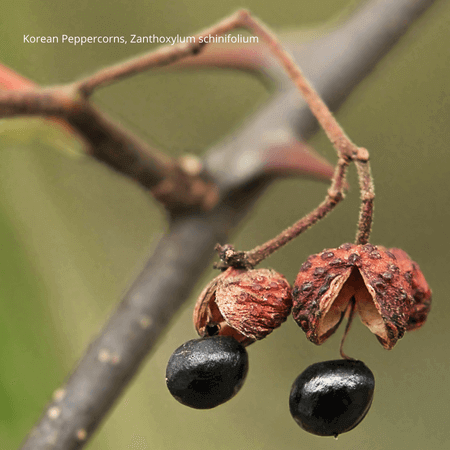
Smooth Mastic-leaf Prickly Ash and Peppertree are also common names for Zanthoxylum schinifolium. 민산초나무 (Min-san-cho-na-mu) is the Korean spelling and pronunciation.
as you can guess, the Korean Pepper Tree native to Korea. it also, grows in Japan (inu-zanshō) and China (qing hua jiao or, 青花椒).
Zone: 5 to 9+
Height: up to 12 feet (3.5m)
Self-fertile: no (Dioecious. Male & female plants needed for seeds [peppercorns])
Sun: Full sun to part shade
Water: medium
Soil: forgiving
Deciduous or evergreen: deciduous
Medicinal¹: yes (discussed below)
Family / Genus: Rutaceae / Zanthoxylum
she’s appears to be thornless. what’s described is a “flat thorn,” which is more like a protrusion rather than a thorn.
Peppercorns
the Korean Pepper Tree produces compact clusters of green to brown-green flowers. it first flowers in July and August. small green to brown-red, spherical, fleshy capsules that contain black seeds will develop IF pollinated by a male. aromatic seeds ripen in October. and those are the Zanthoxylum schinifolium peppercorns!
In Japan, peppercorns are ground and used as pepper. the ground pepper is sprinkled over meat such as grilled eel.
In Korea, the peppercorns are call “Sancho.” whole peppercorns are used in soups and stews.
Korean Pepper Tree Characteristics, Care and Propagation
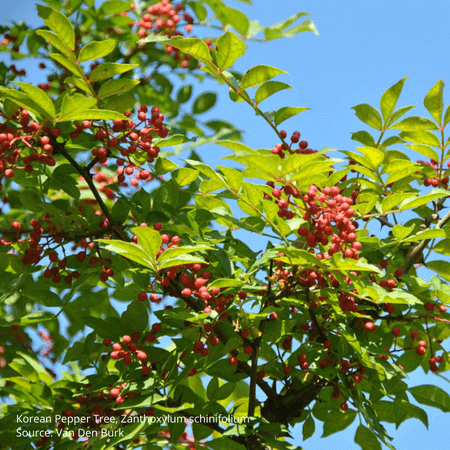
- grow as a single trunk or multi-stemmed plant. you’re pruning will influence that.
- prune in late winter or early spring.
- a good tree for containers.
- “a park tree that has few soil requirements.” so, she can’t be too prickly 😉
- pollinator-friendly for butterflies.
- flowers form on the old wood.
- no evidence of disease or pests. in general, Zanthoxylum species are largely disease free.
Pepper Tree Propagation
Seeds can be sown as soon they’re ripe in fall. they germinate similar to the Goumi (sow seeds when ripe; germination occurs the following spring).
cold stratify stored seed for 3 months. sow seeds early (eg, late winter).
Cuttings of half-ripe wood are taken in July/August. don’t let cutting dry out.
btw, I just learned what “half-ripe” wood is from the Royal Horticultural Society.
Korean Pepper Tree Medicinal and Medical Qualities
Medicinal¹
from Plants For A Future: The pericarp is anaesthetic, diuretic, parasiticide and vasodilator[176]. It is used in the treatment of gastralgia and dyspepsia due to cold with vomiting, diarrhoea, abdominal pain, ascariasis and dermal diseases[176]. It has a local anaesthetic action and is parasiticide against the pork tapeworm (Taenia solium)[176]. The pericarp contains geraniol. In small doses this has a mild diuretic action, though large doses will inhibit the excretion of urine[176]. There is a persistent increase in peristalsis at low concentration, but inhibition at high concentration[176]. The resin contained in the bark, and especially in that of the roots, is powerfully stimulant and tonic[82]. the reference page is here.
Medical¹
research from NIH/PubMed.
in general, i found references to anti-inflammatory and anti-microbial benefits. also, compounds from Zanthoxylum schinifolium are used in cosmetics — to whiten skin :(. finally, one publication cites compounds that “have potential in cancer treatment.”
2. Sansho Pepper Tree, Zanthoxylum piperitum
Fact Sheet
Chopi, Japanese Pepper Tree and Japanese Prickly Ash are also common names for Zanthoxylum piperitum. Sanshō (山椒) in Japan and Chopi (초피) in Korea.
Sansho Pepper Trees are native to Japan, Korea and China.
Zone: 5b to 9
Height: up to 12 feet (3.5m)
Self-fertile: no (Dioecious. Male & female plants needed for seeds [peppercorns])
Sun: Full sun to part shade
Water: medium
Soil: well draining
Deciduous or evergreen: deciduous
Medicinal¹: yes (discussed below)
Family / Genus: Rutaceae / Zanthoxylum
young leaves and shoots are used in soups and salads!
the bark or its peppery leaves are used as a spice too! rice can be flavored with leaves of the Sansho Pepper Tree.
flowers of the male plant are consumed as hana-sanshō.
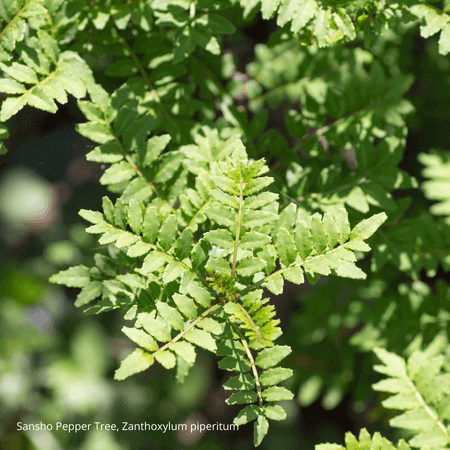
Peppercorns
Sansho Pepper Trees produce compact clusters of green flowers that open in June. small reddish spherical fleshy capsules develop IF pollinated. these contain black seeds. however, I read that green peppercorns are consumed. that, green peppercorns have a strong citrus flavor, reminiscent of yuzu or grapefruit. (Yuzu is Citrus junos, which is thriving at HEPPY™!!)
In China, peppercorns are ground and dry-roasted fruit is an ingredient of the Chinese ‘five spice powder’.
In Japan, mature peppercorns are ground and used as pepper. it’s known as “Japanese pepper” or kona-zanshō (粉ざんしょう). ground Sansho peppercorns are the standard spice for sprinkling on broiled or grilled freshwater eel (kabayaki-unagi). also, Sansho pepper is one of the main ingredients in shichimi (a blended spice).
In Japan, immature green berries are called “green sansho” or ao-zanshō. they are blanched and salted, or simmered using soy sauce into dark-brown tsukudani, which is eaten as condiment.
are ground and used as pepper. it’s known as “Japanese pepper” or kona-zanshō (粉ざんしょう). ground Sansho peppercorns are the standard spice for sprinkling on broiled or grilled freshwater eel (kabayaki-unagi). also, Sansho pepper is one of the main ingredients in shichimi (a blended spice).
In Korea, both the leaves and seeds (peppercorns) are used as an aromatic and flavoring.
Sansho Pepper Tree Characteristics, Care and Propagation
- grow as a shrub or multi-stemmed small tree.
- versatile food & condiment: young leaves and shoots are consumed; and bark and leaves are used as a spice; flowers of the male plant are consumed as hana-sanshō; and of course, female plants provide peppercorns!
- prune in late winter or early spring.
- use Zanthoxylum Piperitum for Bonsai
- a good tree for containers.
- flowers form on the old wood.
- pollinator-friendly for butterflies. it’s a host plant for several indigenous swallowtail butterfly species in Japan.
- Sansho is not bothered by pests or diseases.
- I BELIEVE the Sansho will sucker “but with a limited spread.”
Pepper Tree Propagation
Seeds can be sown as soon they’re ripe in fall. they germinate similar to the Goumi (sow seeds when ripe; germination occurs the following spring).
cold stratify stored seed for 3 months. sow seeds early (eg, late winter).
Cuttings of half-ripe wood are taken in July/August. don’t let cutting dry out.
btw, I just learned what “half-ripe” wood is from the Royal Horticultural Society.
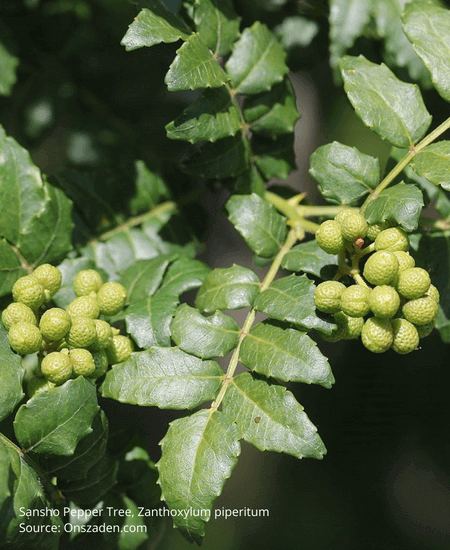
Sansho Pepper Tree Medicinal and Medical Qualities
Medicinal¹
from Plants For A Future: Antiperiodic, antitussive, carminative, diuretic, parasiticide, stimulant[178]. The fruit contains a essential oil, flavonoids and isoquinoline alkaloids[279]. It is anthelmintic, antibacterial, antifungal and stomachic[279]. It inhibits the synthesis of prostaglandin and, in larger doses, is toxic to the central nervous system[279]. It is used in Korea in the treatment of tuberculosis, dyspepsis and internal parasites[279]. The resin contained in the bark, and especially in that of the roots, is powerfully stimulant and tonic[82]. the reference page is here.
Medical¹
research from NIH/PubMed.
gastric cancer:
an extract of Zanthoxylum piperitum appears to decrease the cell proliferation and induces apoptosis (cell death) of AGS. AGS is a common form of gastric cancer.
rheumatoid arthritis:
Zanthoxylum piperitum fruits have been demonstrated favorable clinical efficacy on rheumatoid arthritis. this study attempted to explain why and how (elucidated) Z. piperitum reduces rheumatoid arthritis.
osteoporosis (loss in bone density):
Zanthoxylum piperitum may prove to be a therapeutic agent for osteoporosis.
i found no reports of adverse effects. however, you should ALWAYS empower yourself by double checking these and other studies.
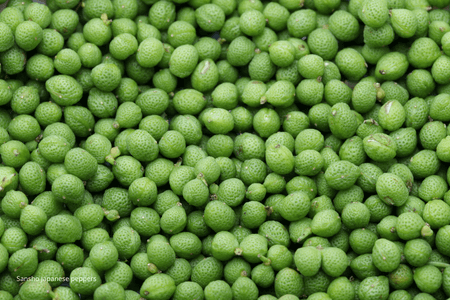
3. Sechuan Pepper Tree, Zanthoxylum simulans
Fact Sheet
Chinese Pepper, Chinese Prickly-ash, Flatspine Prickly-ash, Sichuan Pepper, Szechuan Pepper are also common names for Zanthoxylum simulans. 민산초나무 (Min-san-cho-na-mu) is the Korean spelling and pronunciation.
the Sechuan Pepper Tree is native to China and Taiwan.
Zone: 6 to 9
Height: up to 15 feet (4.5m)
Self-fertile: no (Male & female plants needed for peppercorns)
Sun: Full sun to part shade
Water: medium
Soil: well draining
Deciduous or evergreen: deciduous
Medicinal¹: yes (discussed below)
Family / Genus: Rutaceae / Zanthoxylum
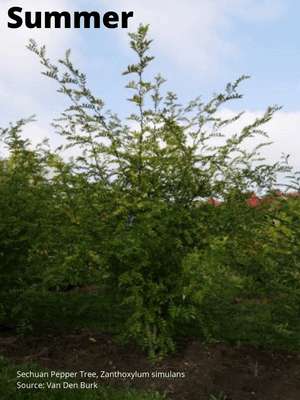
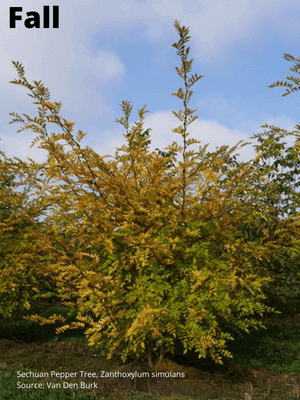
Peppercorns
in May through June the Sechuan Pepper Tree produces clusters of green flowers. small green, round and fleshy capsules (“fruit”) will develop IF pollinated by a male. in August, the small fruits will evolve to a pinkish-reddish color that split open to release its black seeds. those are Zanthoxylum simulans peppercorns!
In China, peppercorns are ground and used as pepper. it’s used whole or ground into a powder and used as a table seasoning. reportedly “a pepper flavour, it is stronger and more pungent than black pepper…A light roasting brings out more of the flavour” (Plants for a Future).
In China, peppercorns are used in the Chinese ‘five spice’ mixture.
the young shoots, flowers, berries, and seeds of this plant are all used in making unique and delicious spices (One Green World).
Sechuan Pepper Tree Characteristics, Care and Propagation
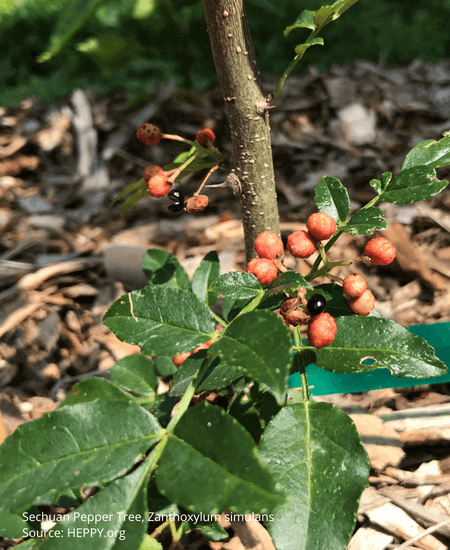
- can tolerate deep shade as well as full sun.
- valuable for bees and butterflies
- generally, a multi-stemmed plant. you’re pruning will influence that. our Sechuan arrived as a single stem plant, and is growing single stemmed.
- prune in late winter or early spring.
- a good tree for containers.
- flowers form on the old wood.
- no evidence of disease or pests. in general, Zanthoxylum species are largely disease free.
- Thorny branches make this a good barrier plant.
Pepper Tree Propagation
Seeds can be sown as soon they’re ripe in fall. they germinate similar to the Goumi (sow seeds when ripe; germination occurs the following spring). cold stratify stored seed for 3 months. sow seeds early (eg, late winter).
Cuttings of half-ripe wood are taken in July/August. don’t let cutting dry out.
btw, I just learned what “half-ripe” wood is from the Royal Horticultural Society.
Sechuan Pepper Tree Medicinal and Medical Qualities
Medicinal¹
from Plants For A Future: Astringent, diaphoretic, emmenagogue[116, 178]. The pericarp is anaesthetic, diuretic, parasiticide and vasodilator[176]. It is used in the treatment of gastralgia and dyspepsia due to cold with vomiting, diarrhoea, abdominal pain, ascariasis and dermal diseases[176]. It has a local anaesthetic action and is parasiticide against the pork tapeworm (Taenia solium)[176]. The pericarp contains geraniol. In small doses this has a mild diuretic action, though large doses will inhibit the excretion of urine[176]. There is a persistent increase in peristalsis at low concentration, but inhibition at high concentration[176]. The leaves are carminative, stimulant and sudorific[147, 218]. The fruit is carminative, diuretic, stimulant, stomachic and tonic[147, 218]. The seed is antiphlogistic and diuretic[218]. A decoction of the root is digestive and also used in the treatment of snakebites[218]. The resin contained in the bark, and especially in that of the roots, is powerfully stimulant and tonic[82]. the reference page is here.
Medical¹
except for one study, NIH/PubMed has little research on Zanthoxylum simulans. that’s unusual for a plant that’s been used for hundreds or thousands of years.
gastric cancer:
Berberine and Chelerythrine are alkaloids found in Zanthoxylum simulans “with significant anti-proliferative activity against gastric carcinoma.”
otherwise:
i found references to “a potential source of natural antibiotics.” also, it “may be an alternative source of anthelmintic agents to control gastrointestinal nematodes in sheep,” in case you farm sheep :/
for many years i’ve reviewed studies in PubMed. i cannot remember the last time I found so little research on a plant that’s been used for so many centuries.
4. Tasmanian Mountain Pepper Tree, Drimys lanceolata (Tasmannia lanceolata)
Fact Sheet
Australian Pepper, Tasmanian Pepperberry, Mountain Pepper and Pepper Tree are also common names for Tasmanian Mountain Pepper Tree.
this girl does not belong to the Zanthoxylum genus. however, the genus for this plant is “unresolved.” the genus is Drimys or Tasmannia. Drimys lanceolata is synonymous with Tasmannia lanceolata. some experts currently advocate moving Drimys lanceolata into the genus Tasmannia as Tasmannia lanceolata.
it’s native to South Australia and Tasmania.
Zone: 8 to 10 (zone 7 with protection)
Height: up to 10 feet (3.0m)
Self-fertile: no (Dioecious. Male & female plants needed for seeds [peppercorns])
Sun: Full sun to part shade (part shade is best in hot climate)
Water: medium (plants under 5 years old are NOT drought tolerant)
Soil: well draining
Deciduous or evergreen: deciduous
Medicinal¹: yes (discussed below)
Family / Genus: Winteraceae / Tasmannia
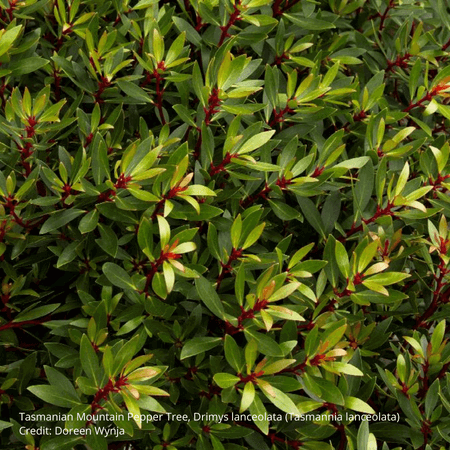
Peppercorns
the Tasmanian Mountain Pepper Tree produces pale yellow to creamy white flowers in April-May (Oct/Nov in Southern Hemisphere). male flowers have more petals (5-8) than female flowers (4 petals). if pollinated, female flowers will develop berries. these fruits gradually turn from green, to red to dark purple or black (up to 1/3” diameter). the fruit and seed ripen in September to October (Apr/May in Southern Hemisphere). and those are the Drimys lanceolata peppercorns!
In Australia:
- peppercorns are ground and are a substitute for conventional pepper.
- leaves are milled and used as a cooking spice.
- leaves are a bay leaf replacement. it loses some heat when cooked, adding depth and subtle spice to soups, dahls and roasts.
- leaves or fruit (am not sure) are used as tea (SBS).
- use Drimys lanceolata with anything roasted or grilled (red meat, lamb, mushroom, seafood, fish & marinade).
- Indigenous people use whole peppercorns or crush the spice into a paste, and apply the pepper to toothaches or sore gums. more about it’s medicinal and medical qualities is below!
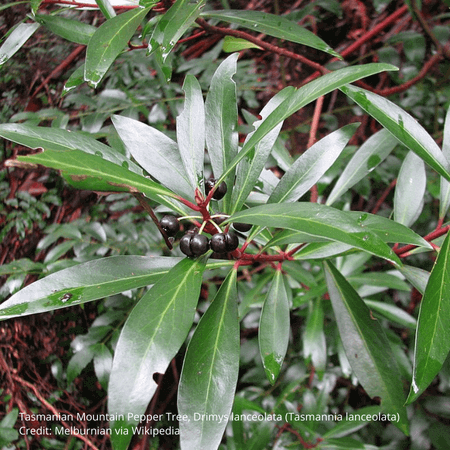
Tasmanian Mountain Pepper Tree Characteristics, Care and Propagation
- evergreen.
- aromatic leaves.
- pest & disease free.
- some shade and water are important.
- adaptive: she grows from sea level to alpine regions.
- showy red stems with deep glossy green leaves (pale green underneath leaves).
- plant on a mound (flat land) or slope. she is susceptible to root rot (Phytophthora).
- prune to any shape; prune after harvest or in the winter to maintain size and shape.
Missouri Botanical Garden writes, “Prefers part shade. Soils should not be allowed to dry out. Site in sheltered locations.”
Pepper Tree Propagation
Cuttings is the best option. take tip cuttings in late autumn, remove the lower leaves and trim the remaining leaves in half. dip the ends into a rooting hormone, and use a propagating soil mix. cuttings propagate best in a warm spot and water regularly to keep the mix moist (Bunnings). rooting can take as long as 12 months. here’s an Australian horticulturalist on YouTube propagating Tasmanian Mountain Pepper.
Seeds MAY require scarification (nicking, breaking, softening, or otherwise weakening of the seed coating to speed up or improve germination).
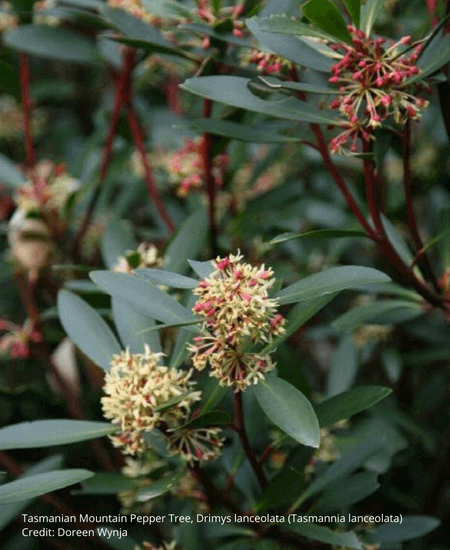
Tasmanian Mountain Pepper Medicinal and Medical Qualities
Medicinal¹
from Plants For A Future: Antiscorbutic, stomachic[152]. the reference page is here.
from an NIH study: “The berries, leaves and bark of this species have historical uses as food and medicine.”
Medical¹
research from NIH/PubMed. search by the Tasmanian Mountain Pepper Tree’s alternate specifies name to find more hits (Tasmannia lanceolata).
anticancer:
three Australian native plants were assessed. all three “herb extracts reduced the proliferation of colon, stomach, bladder and liver cancer cells.” the study is not free to the public. a study’s full version provides important details. the 3 “herbs” studied were Tasmanian Mountain Pepper leaf (Tasmannia lanceolata), anise myrtle (Syzygium anisatum) and lemon myrtle (Backhousia citriodora).
Antioxidative and therapeutic potential:
“plants identified in this review which showed high Total Phenolic Content (TPC) and antioxidative capacity, and hence prominent bioactivity, included Tasmannia lanceolata….”
total phenolic content (TPC) and antioxidant activities:
extracts from three Australian native plants were assessed. “Overall, higher antioxidant activity was found in mountain pepper and tamarind … [and] Mountain pepper showed the highest TPC….” also, “The highest number of bioactive metabolites (62) were identified in mountain pepper….”
however, “Despite the promising antioxidant capacity of the phytochemical profiles of finger lime, mountain pepper, and tamarind extracts [5,7,58,59], there is limited understanding of their potential toxicological effects in live vertebrate models.” the 3 plants studied were Finger Lime (Citrus australasica), Mountain Pepper (Tasmannia lanceolata), and Small-leaved Tamarind (Diploglottis australis).
5. Hercules Club (Southern Prickly Ash), Zanthoxylum clava-herculis
Fact Sheet
Hercules’ Club and Pepperwood are common names for Zanthoxylum clava-herculis. it ALSO has the same common names of the Toothache Pepper Tree, Zanthoxylum americanum (ie, Toothache Tree or Tingle Tongue).
it is a plant native to southeastern U.S., in North America.
Zone: 7 to 9
Height: up to 30 feet (9.0m)
Self-fertile: no
Sun: Full sun to part shade
Water: medium
Soil: forgiving. Tolerates poor soils.
Deciduous or evergreen: deciduous
Medicinal¹: yes (discussed below)
Family / Genus: Rutaceae / Zanthoxylum

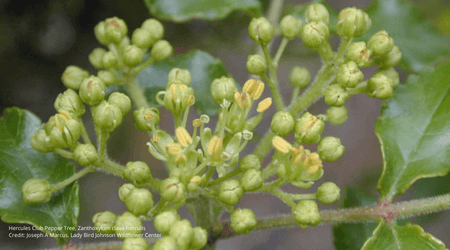
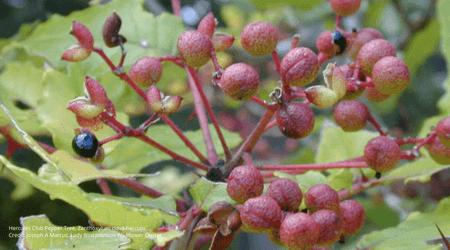
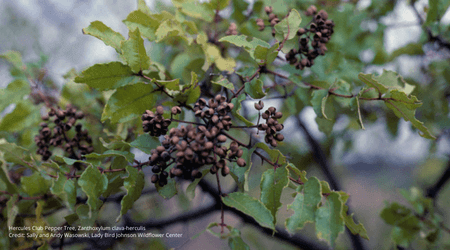
Peppercorns
there is no documented use of peppercorns from the Hercules Club (Southern Prickly Ash), Zanthoxylum clava-herculis.
HEPPY™ recommends not using peppercorns from Zanthoxylum clava-herculis. in fact, Plants for a Future describes known hazards.
Hercules Club Pepper Tree Characteristics, Care and Propagation
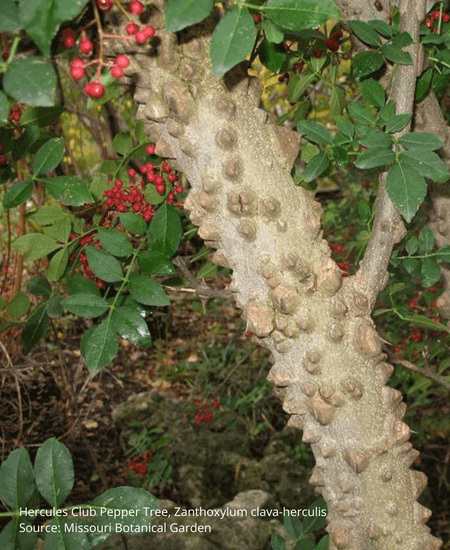
- distinctive spined thick, corky lumps on the bark.
- EXCELLENT erosion control; Hercules Club colonize by root suckers to form dense thickets.
- pollinator-friendly and insect host. several insects such as the Giant Swallowtail and the Leaf Beetle.
- wildlife food. browsed by deer, and small mammals and birds eat the seeds. birds spread the Hercules after passing the seeds.
- aromatic leaves, bark and flower.
- use in native garden, or as hedge, privacy screen.
- grow as a single trunk or multi-stemmed plant. you’re pruning will influence that.
- does NOT thrive is dry soil.
- no serious disease. host insects harvest leaves.
- Cotton Caterpillar repellent and possible other insecticidal properties. Mentioned in a 1948 USDA publication. Author Martin Jacobson cites an 1885 report by Charles V. Riley.
Pepper Tree Propagation
Seeds can be sown as soon they’re ripe in fall. they germinate similar to the Goumi (sow seeds when ripe; germination occurs the following spring).
cold stratify stored seed for 3 months. sow seeds early (eg, late winter).
Cuttings of half-ripe wood are taken in July/August. don’t let cutting dry out.
btw, I just learned what “half-ripe” wood is from the Royal Horticultural Society.
Hercules Club Medicinal and Medical Qualities
Medicinal¹
from Native American Ethnobotany: Houma Indians of Louisiana made a poultice of grated root and bark applied to aching teeth. they also made a salve of grated root mixed with whiskey rubbed on swollen limbs.
from Missouri Botanical Garden: Native Americans and early settlers reportedly chewed the bark and leaves of this tree as a toothache remedy (oils produce a tingling/numbing sensation in the mouth), hence the additional common names of toothache tree, tingle tongue and pepperbark.
from Plants For A Future: This species is quite widely used in herbal medicine, it has the same properties as Z. americanum, but is said to be more active[4]. All parts of the plant, but especially the bark and roots, contain the aromatic bitter oil xanthoxylin[4]. This has a number of applications in medicine[4]. The fruit has a similar medicinal action to the bark[4]. The bark and roots are irritant, odontalgic and antirheumatic[213]. Along with the fruit they are diaphoretic, stimulant and a useful tonic in debilitated conditions of the stomach and digestive organs[4]. They produce arterial excitement and are of use in the treatment of fevers, ague, poor circulation etc[4]. The fruits are considered more active than the bark, they are also antispasmodic, carminative, diuretic and antirheumatic[4, 213, 222]. The pulverized root and bark are used to ease the pain of toothache[213, 222]. One report says that it is very efficacious, but the sensation of the acrid bark is fully as unpleasant as the toothache[213]. Chewing the bark induces copious salivation[222]. Rubbing the fruit against the skin, especially on the lips or in the mouth, produces a temporary loss of sensation[K]. A tea or tincture of the bark has been used in the treatment of rheumatism, dyspepsia, dysentery, heart and kidney troubles etc[222]. A tea made from the inner bark has been used to treat itchy skin[213]. the reference page is here.
Medical¹
NIH/PubMed studies are limited. two studies examined it’s use on cellulite, and multi-drug resistant methicillin-resistant Staphylococcus aureus.
search using the keyword, Zanthoxylum clava-herculis.
6. Toothache Tree (Northern Prickly Ash), Zanthoxylum americanum
Fact Sheet
Common Pricklyash, Yellow Wood and Tingle Tongue are also common names for Zanthoxylum americanum. Formerly known as Xanthoxyum americanum.
it is a plant native to the eastern half of the U.S., in North America.
Zone: 3 to 7
Height: up to 20 feet (6.0m). often grows 8-10′ in the wild as a multi-stemmed shrub.
Self-fertile: no
Sun: Full sun to part shade
Water: medium
Soil: forgiving. Tolerates poor soils.
Deciduous or evergreen: deciduous
Medicinal¹: yes (discussed below)
Family / Genus: Rutaceae / Zanthoxylum
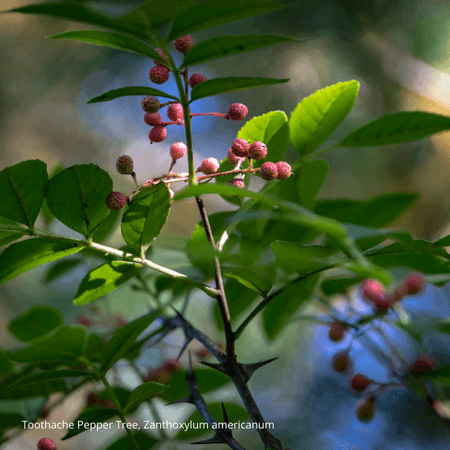
Peppercorns
there is no documented use of peppercorns from the Toothache Pepper Tree (Northerm Prickly Ash), Zanthoxylum americanum. Native Americans used Z. americanum extensively but I see no evidence of ingesting it (see below).
HEPPY™ recommends not using peppercorns from Zanthoxylum americanum. Plants for a Future describes known hazards.
Toothache Tree Characteristics, Care and Propagation
- flowers form on the old wood.
- no serious disease. host insects harvest leaves.
- EXCELLENT erosion control; Hercules Club colonize by root suckers to form dense thickets.
- pollinator-friendly and insect host. several insects such as the Giant Swallowtail.
- aromatic leaves, flowers, fruit, bark and roots (lemony fragrance).
- use in native garden, or as hedge, privacy screen.
- grow as a single trunk or multi-stemmed plant. you’re pruning will influence that.
- Japanese Beetle repellent and possible other insecticidal properties. Studied in 1932; “effective” Japanese Beetle repellent on corn, apple and small peach trees (pages 9-10).
Pepper Tree Propagation
Seeds can be sown as soon they’re ripe in fall. they germinate similar to the Goumi (sow seeds when ripe; germination occurs the following spring).
cold stratify stored seed for 3 months. sow seeds early (eg, late winter).
Cuttings of half-ripe wood are taken in July/August. don’t let cutting dry out.
btw, I just learned what “half-ripe” wood is from the Royal Horticultural Society.
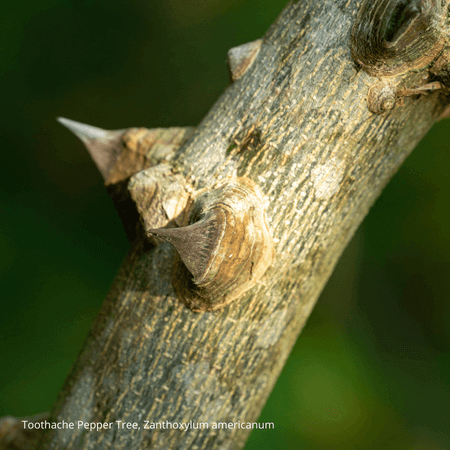
Toothache Tree Medicinal and Medical Qualities
Medicinal¹
from Native American Ethnobotany: nine (9) Native American tribes used Toothache Pepper Tree, Zanthoxylum americanum. it was used as a Toothache Remedy, Dermatological Aid, Cold Remedy, Pulmonary Aid, Gastrointestinal Aid, Gynecological Aid, Kidney Aid, and more.
from Missouri Botanical Garden: commonly called toothache tree because Native Americans chewed the bark or fruits (producing a numbing effect) for relief from toothache pain. Native Americans also prepared a variety of medicinal decoctions from the bark and roots for treatment of such problems and fever, coughs, gonorrhea, rheumatism and external wounds.
from Plants For A Future: Prickly ash is a warming, stimulating herb that is beneficial for the circulation. It was highly regarded by the native North American Indians who used it especially to alleviate rheumatism and toothache[254]. All parts of the plant, but especially the bark and roots, contain the aromatic bitter oil xanthoxylin[229]. This has a number of applications in medicine, especially in the treatment of arthritic and rheumatic conditions, digestive problems and leg ulcers[229, 254]. The fruit has a similar medicinal action to the bark[4]. The bark and roots are irritant, odontalgic and antirheumatic[213]. Along with the fruit they are diaphoretic, stimulant and a useful tonic in debilitated conditions of the stomach and digestive organs[4]. They produce arterial excitement and are of use in the treatment of fevers, ague, poor circulation etc[4]. The fruits are considered more active than the bark, they are also antispasmodic, carminative, diuretic and antirheumatic[4, 213, 222]. The pulverized root and bark are used to ease the pain of toothache[213, 222]. One report says that it is very efficacious, but the sensation of the acrid bark is fully as unpleasant as the toothache[213]. Chewing the bark induces copious salivation[222]. Rubbing the fruit against the skin, especially on the lips or in the mouth, produces a numbing effect[K]. A tea or tincture of the bark has been used in the treatment of rheumatism, dyspepsia, dysentery, heart and kidney troubles etc[222]. A tea made from the inner bark has been used to treat itchy skin[213, 257]. the reference page is here.
Medical¹
NIH/PubMed studies are limited. one study examined it’s antifungal properties. another study found weak or no antimicrobial activity against Neisseria gonorrhoeae.
this plant is not thoroughly studied.
search using the keyword, Zanthoxylum americanum.
On this page:
- Allium species
- Allium Health Benefits
- What’s the Difference?
- Garlic Chives vs Chives
- Green Onion vs Scallion
- Garlic vs Elephant Garlic
- Cultivated vs Uncultivated Allium species
- Cultivated
- Chinese Onion, Allium chinense
- Chives, Allium schoenoprasum
- Elephant Garlic, Allium ampeloprasum var. ampeloprasum
- Garlic, Allium sativum
- Garlic Chives, Allium tuberosum
- Green Onion (aka, Scallion or Bunching Onion), Allium fistulosum
- Leek, Allium ampeloprasum
- Onion, Allium cepa
- Shallot, Allium cepa var. aggregatum
- Uncultivated
- Field Garlic, Allium oleraceum
- Ramp, Allium tricoccum
- Wild Garlic, Allium vineale (also, Wild Onion)
- Wild Leek, Allium ampeloprasum
- Allium bisceptrum
Allium canadense
Allium validum
Allium ursinum
- Cultivated
Pepper Trees growing at HEPPY™
Intro' to Pepper Tree plants at HEPPY
this vid shows our two Pepper Tree during their first 3 months at HEPPY™.
we look forward to adding a Tasmanian Mountain Pepper Tree, Drimys lanceolata (Tasmannia lanceolata) in 2023.
subscribe to our YouTube channel and follow our Pepper Trees over time. from planting to pruning to maintenance & care, to harvesting. if we can do then so can YOU!
Pepper Tree cultivars
Sechuan Pepper Tree, Zanthoxylum simulans
named, “She She”, she immediately started growing. she’s moving fast, and with virtually no care. she’s grown about 8-10″ in the first three months!
we was already pollinated when She She arrived in 2022.
Sansho Pepper Tree, Zanthoxylum piperitum
named, “Sansho”, he’s doing what most guys do. he’s laying around, enjoying the sun and sucking up nutrients 😉
Sansho arrived in 2022. I peeked under the soil surface and saw plenty of white roots everywhere. he’s doing very well.
References
Korean Pepper Tree: Cooksinfo | Van den Berk, The Netherlands
Sansho Pepper Tree: MasterClass | Savor Japan | Seeds Gallery | Van den Berk, The Netherlands | Wikipedia
Sechuan Pepper Tree: Gernot Katzer’s Spice Pages | One Green World | Van den Berk, The Netherlands | Wikipedia
Tasmanian Mountain Pepper Tree: American Meadows | Good Food | Bunnings | Missouri Botanical Garden | SBS
Hercules Club Pepper Tree: Missouri Botanical Garden | Native American Ethnobotany | NC State University, NC Extension
Toothache Tree: Missouri Botanical Garden | Native American Ethnobotany | Wikipedia
General for genus, Zanthoxylum: Royal Botanic Gardens, Kew
Plants for a Future: Korean, Zanthoxylum schinifolium | Sansho, Zanthoxylum piperitum | Sechuan, Zanthoxylum simulans | Tasmanian Mountain, Drimys lanceolata | Hercules Club, Zanthoxylum clava-herculis | Toothache Tree, Zanthoxylum americanum
Insecticidal properties:
1. Fourth Report of the United States Entomological Commission (revised edition and the Final Report) on the Cotton Worm…. Charles V. Riley, Ph.D. 1885.
*** there’s some confusion. Metzger cited Zanthoxylum clava-herculis as a Cotton Caterpillar repellent, and cited Riley’s Report (1948, page 1). But Riley’s report cites Zanthoxylum carolinianum (page 185).
2. Repellency To The Japanese Beetle of Extracts Made from Plants Immune to Attack. F. W. Metzger and D. H. Grant, 1932.
3. Herculin, A Pungent Insecticidal Constituent of Southern Prickly Ash Bark. Martin Jacobson, 1948.
Disclosoure
1 HEPPY cannot take any responsibility for any adverse effects from the use of plants. Always seek advice from a professional before using a plant for food or medicinally. This information is intended for educational purposes only and should not be considered as a recommendation or an endorsement of any particular medical or health treatment.
